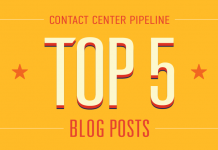
The New Year always brings hope for new beginnings. And there were the signs of that in 2021. What with the rollout of vaccines to end the COVID-19 pandemic, and with it hopefully the ending of restrictions on (and fear of) in-store shopping and also travel, and fresh economic growth that has freed up demand for the latest (and no doubt need to be supported) goods and services.
However, and unfortunately, these positive developments were (and continue to be) partially stymied by vaccination opposition, new virus variants, supply chain issues, climate-change-driven disasters, and “the Great Resignation” of fed up, overworked, and underpaid often frontline workers.
Contact centers are at the heart of these matters. Whether it is a customer who is having new phone activation issues, inquiring about electric vehicle charging, checking on a trip, ordering online, finding out about their loved ones or when their power will be restored, or working out debt repayment, the center is there, with frontline live agents supplemented by automated assistance.
Which actually is not really that different from what contact centers have done all along. As the French journalist Alphonse Karr was reported to have said: “plus ca change, plus c’est la meme chose”, which translates to, and becoming a proverb that says, according to Wiktionary, “the more things change, the more they stay the same.”
Having worked through what hopefully will be the worst of these events, the contact center industry appears to be moving forward on a wide range of issues. Like managing agent turnover, meeting ever-higher customer expectations (and on new channels), and adapting to “the New Normal” of work-from-home (WFH)/hybrid working.
To provide advice and guidance for contact centers on these matters and others in 2022 we have reached out to our Advisory Board. Read on for their insights on strategic initiatives, new solutions and tools, their recommendations, and for words of inspiration.
Mike Aoki
President, Reflective Keynotes, Inc.
My fearless prediction is employee engagement and retention will be critical contact center issues for 2022. The “Great Resignation” means front line staff have more employment choices and less reason to stay if they are dissatisfied with their current employer.
While artificial intelligence (AI) chatbots and virtual agents can take up some of the slack, how do you keep your best agents? What will make their work more meaningful? How can you engage WFH employees? How can you make a hybrid staffing environment work for all employees? Those are key questions to help reduce agent turnover.
Sangeeta Bhatnagar
SB Global Human Capital Solutions, GTACC Chair
When looking ahead and thinking about how our contact centers can successfully move forward, there are many perspectives to consider.
With all the talk around AI and the amazing new technologies we have, I echo what many HR professionals say and that is “the future of work is human.”
I would like to focus on the adaptability across ALL levels when looking for the best talent to acquire, retain, and develop within your organization. With the workplace changing so rapidly over the last two years, so too has the expectations from employees, employers, and customers.
There will be a need for adaptive leadership as employees are in the driver’s seat today. With customers expecting more, there will need to be an increased commitment to providing a world-class employee experience to ensure you keep the best talent AND to ensure top-tiered customer experiences are delivered.
As customers’ expectations continue to change, along with the variety of channels and work environment locations (fully remote, hybrid, fully onsite), we need our team members to have a high adaptability level. We need to look at human-centric ecosystems, service standards, and mindset.
Regardless of location, work environments need to be set up to support employees with the “whole-person” in mind. Since every call, email, and employee/customer interaction can be different, every team member needs to be able to plan and respond to a variety of situations, which requires adaptability with thought, emotions, and actions.
When speaking with industry leaders over the time of the COVID-19 pandemic, many of them have stated that the profile of someone who can be successful has changed.
On top of the regular requirements of desire to learn, having the customer-centric service attitude of going the extra mile, and strong listening skills, companies now require new hires to have a positive mindset and to have a high adaptability level.
Even prior to the pandemic, there were studies showing adaptability and resilience as some of the highest soft-skill requirements. For example, remote working employees need to be able to solve more of their technical issues, using the tools that are there including remote support, as they can no longer have a helpful IT person assist them in-person at their desks.
Regardless of work structure, as leaders, our ability to adapt will be of the greatest service, enabling us to move forward.
Lori Bocklund
President, Strategic Contact
As we close the books on the second calendar year of the New Normal, it’s time to move from a reactive mode of operation and proactively embrace opportunities to optimize. Here are the Top Five things that merit a spot on your radar:
1. Perfect WFH. It’s here to stay. Most agents prefer logging at least some shifts from home and believe they can perform as well (or better) than in-house staff. Moreover, WFH has become a key tool for recruiting and retention. Our recent survey suggests that there’s room for improvement in remote training, coaching, and development. And with agents losing the social connections forged in shared spaces, it’s time to shine a spotlight on employee engagement.
2. Consider cloud technology. When purchasing new or replacement technology, cloud solutions provide the means to move faster, gain new capabilities, and increase agility.
3. Get creative with staffing. Everyone is struggling with hiring, onboarding and training, getting agents to proficiency, and retention. So, centers have to get creative to attract and retain staff. Fair pay, incentive plans, flexible work arrangements, and career paths are long-standing issues that have only increased in importance.
4. Implement desktop technology improvements. This initiative would go a long ways toward flattening out that initial learning curve. Knowledge management, integrated desktop applications, and workflow/next best action tools will all be considerations for helping agents succeed.
5. Automate. Leadership always wants to deflect contacts and get customers to self-serve. And No One wants contacts to be long and painful. So, automation with bots – if only to help with identification and routing – must get higher on people’s “to do” lists. This trend also ties into the staffing challenges and the rise of the cloud!
Tiffany LaReau
Certified Workforce Manager, Human Numbers
My advice is to take a long, hard look at the workforce management (WFM) metrics, goals, and threshold levels to make sure they are still as effective as they once were.
It also may be time for the contact center to reset expectations about what success looks like now, because our customers have certainly changed their expectations.
Many of the drivers behind those original ideals were faulty to begin with. Like the myth of an industry-standard goal and the belief a customer is more interested in how fast we pick up the phone rather than how well we answer their question. Or that abandons don’t cost us any money, so it’s okay to just exclude them from performance metrics.
I would start with abandonment goals first. This was the first metric I saw to really go off the map due to the pandemic. It became erratic because our customers’ tolerance levels surged. This impacted service levels, but it also impacted forecast accuracy and repeat-caller rates.
More recently I’ve seen the opposite correlation between service levels and abandons: callers are becoming more impatient, even with shorter hold times, and that moves it in the opposite direction. Abandonment rate is something that is an output based on staffing levels, so it’s always been more of a living, moving ratio with a moving target rather than a static number.
Finally, if you find your goals aren’t a good fit for your contact center, take the time to do the work and build a business case to support the change, include the stakeholders for their buy-in, request budget approval for the money you need to support the new goals, and then go for it.
Kathleen M. Peterson
Chief Vision Officer, PowerHouse Consulting, Inc.
2021 shed light on contact centers globally. Contact center value was celebrated as centers operated under tough conditions, both business and personal.
The provisioning of WFH agents challenged technology while wide variations in demand challenged leadership, WFM, and the training and support of remote workers. And the recruitment, hiring, and retention of agents challenged everyone!
The New Year brings with it the opportunity to turn the lessons of 2021 into the leadership objectives of 2022. I call this the year to CHALLENGE EVERYTHING.
Work hard on the relationships necessary to assure that the contact center leadership participates in technology investment discussions and decisions that impact the center’s “operational elegance.”
Decide what your WFH and/or premise-based operation really needs to get the job done efficiently and in a way that makes your employees declare your contact center is “a great place to work.”
Challenge your approach to training and staff development. A relatively simple challenge is to commit to investing in proper training development and delivery across multiple channels.
Make a pledge that training in 2022 will not be cancelled! Include coaching sessions in this commitment as well and track training time on a monthly basis.
Well-planned for and consistent training positively impacts job performance as well as job perception. And for the record, I am talking about training beyond the new-hire curriculum. It is a pity when the last training memory of the contact center’s workforce was when they were first onboarded.
Finally, and most importantly, challenge your certainty. For everything is subject to change, and the New Year is a great time to get started down a new path.
Michele Rowan
President, WFH Alliance
On the work front, there’s two big learnings for me that prevail over all the others.
1. We’re never going back to the way things were in the office.
2. Remote work is the safest and most efficient way for many to work long term.
So, if you agree, it becomes quite simple in terms of where we should focus our energy and investments for 2022 and going forward, and that is in remote work structures and hybrid working.
The best place to start is with hiring. Even if you didn’t have material hiring requirements in 2020 or 2021, it’s likely you will be hiring in 2022. But in doing so there are some things to be aware of:
- Many employees stayed on the sidelines long after jobs started opening up again in 2021. Some people decided to stay on unemployment compensation as long as they could, some had no options for child and family care, and some decided to totally re-engineer their careers and priorities via gig work, etc. In response, many businesses implemented material pay adjustments in Q2 2021-Q3 2021 and it’s helping.
- Applicant flow is improving, but competition is still steep in many sectors. Some companies are taking additional steps to improve applicant flow by (temporarily at least) doing away with pre-employment assessment tools, like drug testing, and personality/skills-based assessments. It’s not that these things aren’t important, but they are less important than speed in filling open positions in a labor market that has not fully yet returned to pre-pandemic levels.
- Companies are also announcing “permanent” WFH positions in their job postings, as opposed to office-based positions that are temporarily home-based.
2022 is the right time to review all of your hiring requisites and workflows and ask yourself how they align with your company’s vision, and (how much) they will help—or materially hinder–your core business objectives.
Jennifer Thomas
Director, Customer Care, Jushi Holdings, Inc.
Just breathe.
2020 and 2021 have seemingly blended into each other, leaving many of us still navigating which way is forward.
2021 has been tagged as the “Great Resignation” where we saw people at all levels of organizations exiting: and prioritizing health, happiness, and family.
This is where we all need to take pause, breathe a bit, and absorb what this means to us as individuals and our own organizations.
People can seemingly go anywhere they want and get into any field of work. So, what do we do as leaders? Focus on people.
Every facet of technology is available for contact centers to be flexible, mobile, and efficient in ways we’ve always hoped for. So the focus should start by taking stock in your contact center’s human element and ask the tough questions of yourself and your peers:
- Are your wages still competitive? We now must look not only at contact center roles, but also at other sectors. If entry level at a contact center is now $15/hour but warehouse work is at $17/hour, there must be other factors that would make our work appealing.
- What are the other factors we can offer to the workforce? Learnings from the “Great Resignation” as to why people left are critical. Work/life balance, scheduling flexibility, and WFH options all factor in.
- We know people are choosing life over work, so what is your organization doing to show your people that this is important as well?
Dan Wallis
Vice President of Contact Center Shared Services, Visiting Nurse Service of New York
I am a big advocate for remote contact center work. Few departments lend themselves so easily to remote work, and few functions are so easily defined and tracked as the contact center. I ran my first remote agent pilot in 2001 and have since sent countless people to work at home in their sweatpants and fuzzy slippers.
But, as an example of contradictions, I prefer working in the office. And I’ve been working in our mostly empty offices for more than a year. It’s been sooooo quiet here!
I miss the sounds of an active contact center, where you can feel the energy of hundreds of people asking: “how may I help you today?” I also miss the wallboards with the current stats and the latest competition and the pictures of staff and families.
Mostly, I miss saying hi to the team every day, trying to keep sharp enough to remember the names of hundreds of people, and connecting with each of them in a myriad of different ways.
But for contact centers like ours that virtualized in a hurry 18 months ago, we now must find a way to maintain culture and engagement in a mostly remote world.
While applications like Zoom and Teams are good, it still doesn’t replace the energy of a good team meeting, or the occasional face-to-face meeting with the supervisor, or more intense coaching for a team member who is struggling. These are all cases in which being in the room together appears to drive more favorable results.
The simple fact is that remote work has transitioned from a delighter to a health and hygiene factor in the last two years, and that many agents have become used to it. So we must be careful that changes in the employee experience do not result in resentment or resistance.
Therefore, we make sure that managers and supervisors are able to communicate the value of a face-to-face meeting, so there is a clear understanding of why we insist staff come into the office.
Most, but not all, employees are happy to come in occasionally, but only occasionally! It provides an opportunity to connect and catch up with friends.
As such, we must make time for the social aspects of work, providing a mix of fun and communications. We make sure to focus on those experiences that can’t be replicated over Zoom or Teams, and again to make sure we communicate this to all stakeholders.
Communications consultant Bob Aronson said, “If communication is not your top priority, all of your other priorities are at risk.”
With that mind, we are committed to a steady drumbeat of communication leading staff into a new integration of post-pandemic work environments.
We are focused on identifying and communicating the value proposition of coming into the contact center occasionally. We are working to develop expectations that support both the agent and the supervisor.
In doing this, we hope to maintain the engagement and culture that make our team great, allowing for a new engaging work environment.











